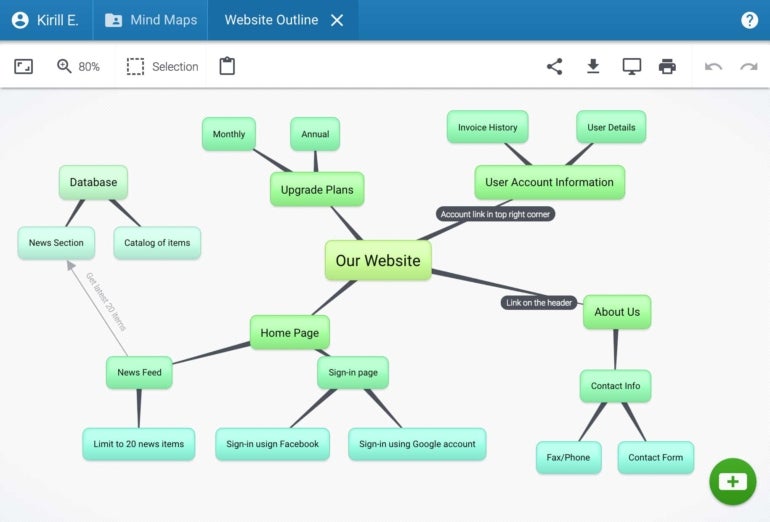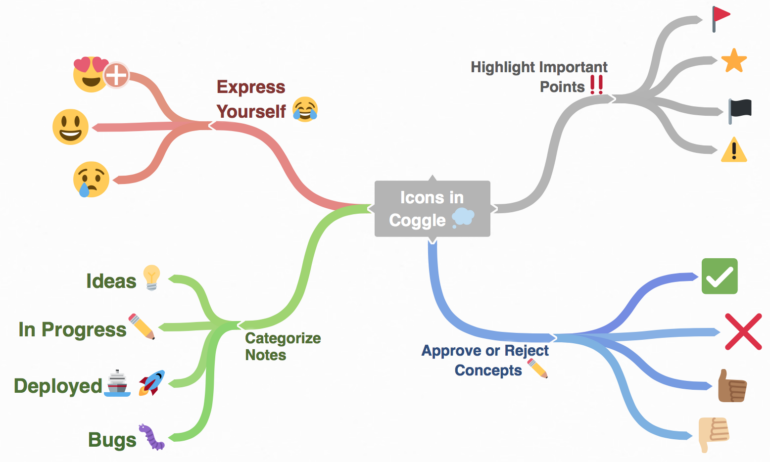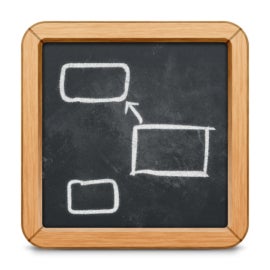- Best for flowchart-like visualization: Lucidchart
- Best for complex workflows: Miro
- Best for versatility: ClickUp
- Best for software development teams: Creately
- Best for students and small teams: Bubbl.us
- Best for ease of use: Coggle
- Best for extensive color and styling options: MindMeister
- Best free brainstorming software: WiseMapping
- Best for intelligent note taking: Scapple
- Best for digital whiteboard and augmented intelligence: Stormboard
The human mind is a complex system with billions of neurons that allow it to perform many functions, one of which is to think and generate ideas. Experts estimate that the mind thinks between 60,000 to 80,000 thoughts a day; this practically means that your mind can conceive thousands of ideas per day, but without a proper way to document these ideas, they would be lost to oblivion. That is where brainstorming software comes in.
Brainstorming software, also known as mind mapping tools, is used to develop creative ideas. It lets you document and organize your thoughts, add visuals or notes to them and create connections between them.
We have carefully curated a list of the best brainstorming software for teams of all sizes across various industries with different needs. We analyzed each tool’s features, pricing and their pros and cons to help you determine the best option for your organization.
Top brainstorming tools: Comparison chart
Here is a comparison feature summary of the best brainstorming software.
| Best for | MindMaps | Mobile app | Starting price | |
|---|---|---|---|---|
| Lucidchart | Flowchart-like visualization | Yes | Yes | $7.95 |
| Miro | Complex workflow | Yes | Yes | $10 per member per month |
| ClickUp | Versatility | Yes | Yes | $10 per user per month |
| Creately | Software development teams | Yes | No | $8 per month |
| Bubbl.us | Students and small teams | Yes | No | $6 per month |
| Coggle | Ease of use | Yes | Yes | $5 per month |
| MindMeister | Extensive color and styling options | Yes | Yes | $4.50 per user per month, billable 6-monthly. |
| WiseMapping | Best free brainstorming software | Yes | No | Free |
| Scapple | Intelligent note-taking | Yes | No | $20.99 |
| Stormboard | Digital whiteboard and augmented intelligence | Yes | Yes | $10 per user per month |
Lucidchart: Best for flowchart-like visualization

LucidChart is an easy-to-use and intuitive web-based brainstorming app that enables individuals, small teams and large enterprises to visualize and structure their ideas. It provides a vast library of shapes to simply drag and drop onto your mind map, allowing you to create complex diagrams, flowcharts and organizational charts with ease. To start your idea boards, you can begin building your diagrams by choosing from a template from the library or importing outlined ideas from a spreadsheet.
Figure A

Pricing
- Free: Available at no cost for up to 3 editable Lucidchart documents, 60 shapes per Lucidchart document and 100 templates.
- Individual: . This plan costs$7.95It includes up to 1 GB of storage.
- Team: It costs $9 per user.
- Enterprise: Custom quote.
Lucid allows you to bundle its Lucidchart and Lucidsparks products offerings as one package.
- Free: You can assess Lucidchart and Lucidspark’s basic features for free.
- Individual bundle: This plan costs $11.93.
- Team Bundle: It costs $13.50 per user.
- Enterprise bundle: Quote available upon request.
Features
- Support collaborative diagramming with team members.
- Drag-and-drop interface.
- Extensive shape libraries.
- Integration with third-party services like Microsoft Teams, Salesforce, Slack, Trello and Visio.
Pros
- Generous free plan.
- Real time collaboration.
- Offers over 500 mind map templates.
Cons
- New users may experience steep learning curves, as the capabilities may take some time to master.
- Some users reported that the tool is somewhat pricey for small businesses.
See how Lucidchart compares to other mind-mapping software for project management.
Miro: Best for complex workflows

Miro is an online workspace that enables distributed teams to brainstorm ideas and create mind maps and roadmaps on a single, infinite canvas. It provides a digital canvas where users can add sticky notes, drawings, images and various other visual elements to organize and share ideas.
Miro offers over 400 templates across various categories, including:
- Meetings and workshops.
- Brainstorming and ideation.
- Research and design.
- Strategy and planning.
- Agile workflow.
- Mapping and diagramming.
Figure B

Pricing
- Free: Best for individuals and teams exploring Miro. Limited to three editable boards and up to five talktracks.
- Starter: Best for teams. It costs $8 per member per month, billed annually or $10 per member per month, billed monthly.
- Business: Best for advanced collaborations. It costs $16 per member per month, billed annually or $20 per member per month, billed monthly.
- Enterprise: Custom quotes. This plan is ideal for enterprises with complex collaboration workflows. It requires a minimum of 30 members.
Features
- Offers 2000+ advanced diagramming shapes from BPMN, UML, AWS, Google, Azure and Cisco.
- Interactive presentation mode.
- Allow you to recover saved board history automatically.
- Versatile export options.
- Whiteboarding capabilities.
Pros
- Offers an extensive library of templates.
- Integrates with 100+ third-party applications, including Zoom, Slack, Google Drive and Sketch.
- Interactive presentation mode.
- Offers a free forever education plan for staff and students of educational institutions.
Cons
- Miro’s advanced features may take time to learn.
- Board owners cannot provide editing access.
ClickUp: Best for versatility

ClickUp is an all-in-one productivity software that allows teams of all sizes to manage projects and tasks and collaborate on ideas. Though ClickUp is primarily a project management tool, its advanced mind map and whiteboard features earned it a spot on our list of the best brainstorming software.
After creating your vision on the ClickUp mind map or whiteboards, you can select and convert the shapes to tasks and assign them to team members. This seamless integration between mind mapping and task management makes ClickUp a powerful tool for brainstorming and idea implementation.
Figure C

Pricing
- Free Forever: Available for unlimited team members.
- Unlimited: $7 per user per month when billed annually or $10 per user per month when billed monthly.
- Business: $12 per user per month when billed annually or $19 per user per month when billed monthly.
- Enterprise: Custom quote.
Features
- There are over 16 ways to visualize your work, including mind map, Gantt, calendar, list, timeline view and whiteboards.
- Offers two mind map options, including node-based and task-based mind maps.
- Drag-and-drop to connect dependencies.
- You can create, edit or delete tasks directly from your Mind Map.
Pros
- Offers over 50 native integrations.
- Native time tracking.
- Generous free plan.
Cons
- It is not primarily designed for brainstorming.
- ClickUp free and unlimited plans mind map capability have a use limit of 60 and 100, respectively.
For more information, read our full ClickUp review.
Creately: Best for software development teams

Creately is a visual collaboration platform that allows you to create, collaborate and share diagrams, draw flowcharts, UML, mind maps, UI mockups, network diagrams and wireframes. It offers a variety of pre-designed templates and a simple drag-and-drop interface to create professional-looking visuals. Creately can be used by individuals, teams and organizations across different industries for brainstorming, planning, problem-solving and communication purposes.
Figure D

Pricing
- Free Forever: Support up to three canvases, one folder, basic Integrations and basic collaboration.
- Personal: This plan costs $5 per month, billed annually or $8 per month, billed monthly.
- Team: This plan costs $10 per month, billed annually or $16 per month, billed monthly.
- Business: This plan costs $89 per month, billed annually or $149 per month, billed monthly.
- Enterprise: Quote available upon request.
Features
- Advanced diagramming and whiteboarding.
- Real-time collaboration.
- Support timelines, grids and kanban boards.
- Project management capability.
- Image export – 4K, high resolution.
Pros
- Ready-to-use templates.
- Infinite canvas.
- OKR and KPI mapping.
- Mind maps, concept maps and decision trees.
Cons
- Creately mobile app can be improved.
- Some users experience occasional lag.
Bubbl.us: Best for students and small teams

If you are on a budget and are looking for a cheap brainstorming tool, Bubbl.us is your go-to solution. The platform simplifies the process of mind mapping and brainstorming, allowing you to organize your thoughts and ideas easily. Its affordable pricing plans will enable you to access all the essential features without breaking the bank. Whether you’re a student working on a project or a professional seeking simple and beginner-friendly solutions, Bubbl.us will do the trick.
Figure E

Pricing
- Basic: Free for up to three mind maps.
- Premium: $4.91 per month, billed annually or $6 per month, billed monthly.
- Team: Minimum of 3 users.$59 per year per user, $177 billed annually or $18 per month, billed monthly.
Features
- Allow you to export your work as JPG, PNG and text.
- You can create and edit mind maps on any device.
- Ability to customize color and font as you wish.
Pros
- It is affordable.
- Offers students, teachers and employees of nonprofit organizations up to 50% discount.
Cons
- The premium plan storage capacity is limited to 5 GB.
- It’s less feature-rich than other tools on our list.
Coggle: Best for ease of use

With Coggle, you can take notes, brainstorm ideas, plan and collaborate with others. It is a simple yet dependable brainstorming platform and its user-friendly interface and intuitive design make it easy for beginners to navigate and use the platform without fuss.
Figure F

Pricing
- Free Forever: No cost for up to 3 private diagrams.
- Awesome: $5 per month.
- Organization: $8 per month.
- Coggle for Enterprise: Custom quote.
Features
- PDF and Image download.
- Export and import as .mm and text.
- Unlimited image uploads.
- Color customization.
Pros
- Offers revision history capability.
- Integration with third-party apps like Asana, Dropbox, GitHub, Google Drive, Jira, MeisterTask, Microsoft Teams, Trello and Typeform.
Cons
- Not suitable for planning complex projects.
- The free and awesome plans lack branded diagrams capability.
MindMeister: Best for extensive color and styling options

MindMeister is an online mind mapping software that allows users to organize and present ideas visually. It provides a collaborative platform for brainstorming, planning, meeting management and note-taking. Users can create and edit mind maps using various templates, colors and styles. MindMeister is accessible on web browsers and offers mobile applications for iOS and Android devices.
Figure G

Pricing
- Basic: Free forever per user.
- Personal: $3.50 per user per month, billable yearly or $4.50 per user per month, billable 6-monthly.
- Pro: $5.50 per user per month, billable yearly or $6.50 per user per month, billable 6-monthly.
- Business: $8.50 per user per month, billable yearly or $10.50 per user per month, billable 6-monthly.
Features
- File and image attachments.
- Team collaboration capability.
- Custom product branding.
- Export to PDF, image, Freemind, XMind, MindManager, text, MindMeister, Microsoft Word and PowerPoint.
- Import from text, Freemind, XMind, MindMeister and MindManager.
Pros
- Multiple export and import options.
- Extensive styling options.
- Versions history.
Cons
- Doesn’t offer a month-to-month plan.
- Limited integrations
WiseMapping: Best free brainstorming software

Budget-conscious individuals and businesses looking for free brainstorming software should consider WiseMapping. This mind mapping tool is based on an open source project and it helps individuals and teams visualize their ideas and create structured diagrams at no cost. It offers various features, such as different layouts and styles, collaboration options, attachable notes and the ability to export and share the created maps.
Figure H

Pricing
WiseMapping is a free, open source tool.
Features
- Export your maps to SVG, PNG, JPG and FreeMind.
- Personal workspace.
- Collaborative workspace.
Pros
- Drag-and-drop function.
- 100% free.
- Excellent for educational use.
Cons
- Limited functions.
- Lacks real-time collaborative editing.
Scapple: Best for intelligent note taking

Do you like documenting your thoughts and ideas for future reference? Literature & Latte’s brainstorming software, Scapple, can help you organize your thoughts, ideas and information. It provides a flexible and freeform interface where you can connect and arrange elements such as text and notes non-linearly. Scapple is commonly used for brainstorming, outlining storyboarding and project planning.
Figure I

Pricing
Scapple offers a 30-day free trial.
- Standard license: $20.99.
- Educational license: $16.79. Only available to students & academics. Requires institutional affiliation.
Features
- Stack notes in columns of related ideas.
- Customize the appearance of notes.
- You can create background shapes to group notes.
Pros
- Allow you to connect notes using drag and drop.
- You can drag notes from Scapple into Scrivener.
Cons
- No mobile app.
- No free forever plan.
Stormboard: Best for digital whiteboard and augmented intelligence

Commonly used for brainstorming sessions, project planning, agile retrospectives and virtual meetings, Stormboard allows teams to remotely collaborate and organize ideas visually and interactively. It provides a virtual whiteboard where users can create sticky notes, add images, drawings and documents and move them around to develop and structure ideas.
Figure J

Pricing
- Personal: Free for up to five users per storm.
- Business: $8.33 per user per month, billed annually or $10 per user per month billed monthly.
- Enterprise: Custom quote.
Features
- Digital sticky notes.
- Real-time collaboration.
- CSV, JSON, XML and OPML raw data exports.
- Word cloud, votes and tasks exports.
Pros
- Visually appealing.
- Intuitive interface and user-friendly.
- Task tracking for project management.
Cons
- Limited functionality.
- Limited storage capacity.
Key features of brainstorming tools
Here are some key features to look out for when shopping for the best brainstorming software for your company.
Templates
Building a mind map from scratch can be overwhelming, especially for those new to brainstorming software. A tool that offers predefined templates for different types of brainstorming sessions (e.g., SWOT analysis, mind mapping, or affinity diagrams) can easily guide you through the process and help structure your ideas.
Integration with third-party applications
Before selecting a brainstorming tool, take inventory of the applications you currently use within your organization. Choose a brainstorming software that integrates with all or most of your apps to ensure seamless workflow and data sharing across platforms. Integration with project management software or task trackers is essential, as it allows for a seamless transition from brainstorming to execution by directly converting ideas into actionable tasks or projects.
Data visualization
The visualization capability provides you with visual representations of complex data and information. Selecting a brainstorming software with data visualization capability allows you to better understand and analyze the ideas generated during a brainstorming session. The tools we explored in this guild enable you to create charts, diagrams, mind maps or other visual representations to connect ideas and identify patterns or trends.
Voting and ranking
Not all brainstorming software providers offer this capability, but it is an essential component of brainstorming software. Voting and ranking features allow team members to vote or rank ideas. This helps identify the most popular or promising ideas, fostering consensus and prioritization.
How do I choose the best brainstorming tool for my business?
The right brainstorming software for you depends on your team size, needs and preferences. If you prioritize affordability, consider Bubbl.us, WiseMapping or Coggle. If you value features and functionalities over money, ClickUp, Miro or Creately are excellent choices. MindMeister allows you to customize and style your mind map tool to suit your needs.
At the same time, Stormboard and Scapple’s note-taking capabilities make them desirable for more free-flowing brainstorming sessions, while Lucidchart’s visualization features make it a good option for creating flowcharts and diagrams during brainstorming sessions.
Methodology
To write this review, we analyzed 25+ brainstorming software. We selected the top 10 that ranked high based on our evaluation of their features, costs, ease of use, interaction with third-party services and customer service and support.
We collected each product’s information from their websites and signed up for a free plan/trial where possible to gain first-hand experience with the tool’s capabilities. We also looked at user reviews to learn about real-world users’ experiences with the brainstorming software. This information was then used to analyze the tool’s strengths and weaknesses.

